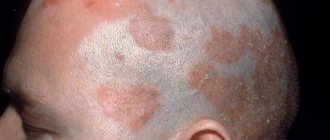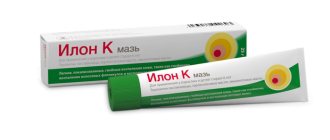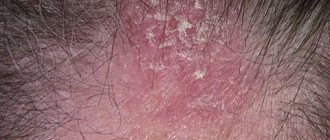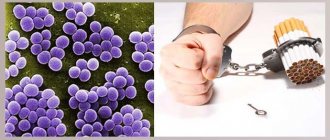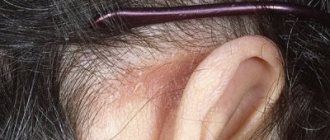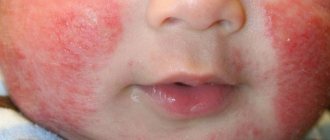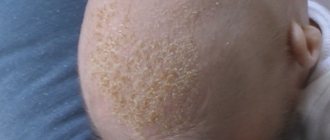What is psoriasis vulgaris?
Psoriasis vulgaris is the most common dermatological disease, affecting 1-4% of the world's population.
Despite visual localization, its diagnosis and treatment still remain an important problem in the lives of millions of people. Like any skin disease, psoriasis vulgaris not only reduces a person’s quality of life, but also causes significant aesthetic discomfort. This can cause mental changes and cause depression and behavioral disorders.
People of all ages are susceptible to plaque psoriasis, but most often it develops in young patients (15-30 years) and after 50 years. Women and men get sick equally often. In the structure of various forms of psoriasis, it ranks first (up to 90% of patients).
Interesting to know! Many historical figures suffered from psoriasis, for example, Henry Ford, John Rockefeller, Vladimir Nabokov, Winston Churchill.
Stages of flow
Like other types of pathology, plaque psoriasis has its own forms and course characteristics.
The disease occurs in three stages. These include:
- Progressive. This stage is characterized by the appearance of more and more new rashes on the patient’s body, and is also accompanied by acute symptoms. The patient's condition is unstable, the signs of the disease are intensifying.
- Stationary stage. Here the growth of papules stops. No new plaques appear on the body. However, the symptoms are still pronounced. The patient is concerned about itching, peeling, and inflammation.
- Regressive. During this period, there is a significant improvement in the patient's condition. Peeling, itching, and redness gradually disappear. The plaques begin to fade from the center and gradually disappear completely.
Photo of vulgar psoriasis
Each stage may last differently for each patient. The duration of the period depends on the characteristics of the person’s immune system, treatment and some other factors.
Why does psoriasis vulgaris occur? What are the risk factors for psoriasis vulgaris?
At the moment, there is no single theory explaining the development of psoriasis vulgaris.
The most important causes of plaque psoriasis are:
Hereditary disorders. The presence of psoriasis in one or both parents sharply increases the likelihood of its occurrence (up to 16-50%). At the moment, many genes have been identified whose interaction can lead to the development of psoriasis vulgaris;- Hormonal disorders. A typical disorder is the chain of interactions between the endocrine glands (pituitary gland, thyroid gland, adrenal glands, etc.). With vulgar psoriasis, there is a decrease in the level of melatonin (sleep hormone), an increase in the content of somatotropin (growth hormone), insulin, prolactin;
- Metabolic disorders. Patients with psoriasis may have disturbances in the metabolism of lipids, cholesterol, and nucleic acids;
- Viruses. At present, it has not been possible to identify a specific virus, however, this theory is supported by the appearance of psoriatic changes after injection of the contents of plaques into laboratory animals;
- Impairments in the functioning of the immune system. This is confirmed by the connection of vulgar psoriasis with autoimmune diseases, specific changes in the body’s immune defense indicators (increased T cells, interleukins);
- Nervous-reflex disorders: stress, emotional overstrain, etc.
Important! Since psoriasis vulgaris is not an infectious disease, contact with the patient is absolutely safe.
There are 2 points of view on the transformation of these causes into the disease itself.
- The basis of psoriasis vulgaris is a primary disruption of the process of maturation, growth and development of cells in the surface layer of the skin, which leads to the appearance of pathologically altered keratocytes and protective activation of one’s own immune system;
- The basis of vulgar psoriasis is a primary disorder in the functioning of the immune system. Blood T cells mistakenly recognize their own keratocytes as foreign and perform their main protective function by releasing biologically active substances. This causes damage to skin cells and their rapid growth in response.
None of the theories can fully explain the development of psoriasis vulgaris.
Related article:
Diet for psoriasis is the key to successful therapy
The implementation of the pathological mechanism is carried out through many predisposing risk factors, which can be decisive in the first episode of the disease:
- Skin trauma (sunburn, insect bites, etc.);
- Infectious diseases (viral, bacterial);
- Intoxication (drugs, chemical agents);
- Atherosclerosis;
- Diabetes mellitus type 1 or 2;
- Alcohol, smoking;
- Excess body weight;
- Pregnancy.
Diagnosis of the disease
Pathology is diagnosed by external examination. The doctor quickly determines the presence of psoriasis plaques. They have a special appearance. In moderate and relatively mild forms of the disease, there are no abnormalities in the blood. This is only possible if there is no treatment, the problem develops and it becomes more complicated. The analysis in this case shows an increased level of ESR and leukocytosis.
In particularly difficult situations, the doctor prescribes a skin biopsy to rule out other dermatological pathologies. This is necessary to rule out a simple allergy or fungus.
When making a diagnosis, the doctor checks whether there are signs of a complex psoriatic triad. We are talking about such manifestations as:
- The appearance of stearin spots;
- Formation of terminal film;
- After removing the crust, spot bleeding appears.
How does psoriasis vulgaris manifest?
The basis of the symptoms of vulgar psoriasis is the psoriatic triad.
It includes three phenomena that are revealed when plaques are scraped from the affected skin:
- The stearin stain phenomenon: when the flake is removed, specific shavings are formed that resemble stearin (a triglyceride used in candle production and soap making). The patient does not experience pain;
Stearic stain - Terminal film phenomenon: the appearance after removal of the stearin stain of a shiny, pink surface resembling plastic film;
Terminal film - The phenomenon of pinpoint bleeding (“bloody dew”): occurs after removal of the terminal film. It consists of superficial capillary bleeding at the site of injury - a positive Auspitz sign.
Pinpoint bleeding
Reference! Joints are the only organ, other than the skin and its derivatives, that are susceptible to psoriasis vulgaris (psoriatic arthritis).
Psoriatic papules
Vulgar psoriasis is characterized by a gradual progression of symptoms, and occasionally an acute onset occurs.
A specific symptom is the appearance of red or pink psoriatic nodules (papules) in certain areas of the body. They have a dense consistency, rise above the level of healthy skin, have clear boundaries and are covered with white-gray scales. The most often affected are the symmetrical articular surfaces of the extremities (knees, elbows), and the scalp.
Depending on the magnitude of the manifestation of symptoms and the prevalence of the process, mild, moderate and severe degrees of plaque psoriasis are distinguished. Their comparative characteristics are presented in the table.
| Criterion (symptom) | Mild degree | Average degree | Severe (widespread psoriasis) |
| Area of affected skin | Less than 3% | 3-10% | More than 10% (or joint involvement regardless of skin manifestations) |
| Disease activity | A slight increase in the number and size of nodules with a tendency to reverse development and disappearance (first, the central part of the papule loses color intensity, and then its periphery). | Moderate growth of nodules with the development of psoriatic plaques (plaque form) with the formation of confluent foci of bright red color | Increased growth of plaques of various configurations, covered with scales. Possible swelling and hardening of psoriatic elements |
| Tendency of plaques to coalesce | No | Characteristic | Significantly expressed |
| Localization | Scalp, skin over knee and elbow joints | Involvement of the lower back, face, and extensor surfaces of the upper and lower extremities | The process spreads to the stomach, neck, etc. |
For a summary assessment of the prevalence of psoriasis, a special scale is used - the PASI index. It evaluates the severity of skin manifestations from 0 to 72 points.
Possible complication - Pustular psoriasis
The course of vulgar psoriasis is chronic, with periods of exacerbation and remission. Most often, deterioration is observed in autumn and winter (winter form of psoriasis), less often in summer. The prosperous period can last weeks to several years. The cause of exacerbation of psoriasis can be stress factors, alcohol intake, disturbances in the hormonal status of the body, etc.
It is also possible to transform vulgar psoriasis into complicated forms: pustular, arthropathic psoriasis, psoriatic erythroderma. This disease is characterized by a wave-like course of the process.
The following stages of vulgar psoriasis are distinguished:
Koebner's symptom
Progressive (acute). It is characterized by the progressive development of vulgar psoriasis, which manifests itself in the appearance of new nodules with a reddish periphery, the growth of existing papules, pronounced formation of scales, and intense peeling. It is easy for a doctor to detect the psoriatic triad. Koebner's symptom is also determined, i.e. the appearance of new plaques at the site of skin trauma (cut, bite, burn). Itching and burning may occur;- Stationary. It consists in stabilizing the development of vulgar psoriasis. The formation of new rash elements does not occur, the old ones retain their size, and the peeling is moderate. The psoriatic triad is still positive, Koebner's sign is negative. As a diagnostic criterion for transition to the next stage, the formation of a Voronov’s rim is used - a silver-colored ring of soft elastic consistency around the psoriatic nodule;
- Regressive (permissions). The final stage of development of vulgar psoriasis, during which there is a gradual decrease in papules and plaques in size and quantity. In their place, a patch of discolored skin forms. The psoriatic triad remains positive, Koebner's sign is negative.
Interesting to know! October 29 is International Psoriasis Day.
Vulgar psoriasis on the elbows
Particular attention is paid to the quality of life of patients with vulgar psoriasis, because They often experience psychological discomfort, problems in social and professional activities due to varying degrees of severity of the cosmetic defect. A significant proportion of patients with vulgar psoriasis are diagnosed with depression, anxiety-phobic and behavioral disorders.
The insidious disease psoriasis
Many modern city residents are familiar firsthand with a chronic inflammatory disease of the skin and joints, psoriasis.
Red-pink spots, “decorated” with flaky pale silver scales, can poison the lives of not only women, who always pay a lot of attention to their appearance, but also stern men, and even carefree small children. The insidiousness of this disease is that absolute recovery cannot be guaranteed by any doctor of Western medicine. Under the influence of therapeutic measures, psoriasis can go into a latent form and remain in it for a long time, from several months to several decades. Therefore, this disease is considered incurable by traditional medicine.
The following stages
development
of psoriasis
:
- progressive. Small dots appear on the patient’s skin (often in places of minor injuries - cuts, scratches, abrasions, etc.), which, gradually enlarging, merge with each other, resulting in the appearance of pinkish spots of various shapes and sizes;
- stationary. After some time (from 1 week to 1 month), new foci of the disease stop appearing on the skin, and old spots begin to peel off, becoming covered with dry, pale silver scales;
- regressive. Peeling noticeably decreases, psoriatic plaques become less bright, many of them disappear, and later than others, spots on the knees and elbows disappear or do not resolve at all.
Who to contact if you suspect psoriasis vulgaris and how is it diagnosed?
A dermatologist is involved in the diagnosis and treatment of vulgar psoriasis. The diagnosis is established based on the clinical picture, patient complaints and medical examination. As a rule, additional examination methods are not required, since there are no strictly specific changes characteristic of plaque psoriasis.
During the period of exacerbation of vulgar psoriasis, a general blood test may reveal an increase in ESR, an increase in the number of leukocytes, and in a biochemical test - an increase in rheumatoid factor, etc.
Skin biopsy is rarely performed in difficult diagnostic cases to exclude other dermatological diseases.
The occurrence of the disease and features of the course
Psoriatic rashes on the surface of the skin form in injured areas. As a rule, significant disruption occurs in areas:
- Burns of varying degrees;
- Erased calluses;
- Injections given.
These phenomena are characterized by the general Koebner phenomenon. This name comes from the famous dermatologist who discovered and described the problem. It is characteristic of psoriasis in 50% of cases and manifests itself in 90% of cases of severe psoriasis.
The described disease is characterized by a seasonal course. In most patients, the disease manifests itself most strongly in cool weather. In some cases, everything happens exactly the opposite, that is, heat contributes to the progression of pathology.
What methods exist for treating psoriasis vulgaris at home?
Outpatient treatment of vulgar psoriasis is carried out under the supervision of the attending physician.
It includes:
Maintaining a daily routine (in order to maintain normal hormonal levels, including melatonin concentrations);- Maintaining a stable psychological state, limiting stressful situations;
- Maintaining hygiene. The use of a washcloth is avoided; the skin must be washed by blotting with a soft material to avoid injury;
- Drug treatment.
The basis of drug therapy for vulgar psoriasis is the use of local drugs: hormonal and non-hormonal.
Non-hormonal ointment with anthralin
Hormonal agents are represented by glucocorticosteroids: Clobetasol, Betamethasone, Triamcinolone. They are available in various dosage forms (ointments, gels, creams, foams, etc.). Ointments are more preferable due to better penetrating ability.
Non-hormonal agents: Calcipotriene (vitamin D), Tazarotene (retinoid), Anthralin, etc. The most effective is a combination of these groups of drugs.
Diet for vulgar psoriasis
Patients with vulgar psoriasis should follow a diet with frequent split meals (up to 5-6 times a day), drink enough water (1.5-2 l), exclude alcoholic beverages and highly allergenic foods. It is recommended to limit salt intake, incl. “hidden” (sausages, smoked meats).
A balanced diet with a predominance of plant foods and lean meats is advisable for patients with vulgar psoriasis. It is periodically necessary to arrange fasting days.
| Authorized Products | Prohibited Products |
| Dairy and fermented milk products, cereals, buckwheat, herbs, fruits and vegetables, lean meats, seafood, fish, vegetable oils (especially flaxseed), low-fat broths | Semi-finished products, canned food, spicy, fried foods, citrus fruits, baked goods, sweets, chocolate, flour products, potatoes (limited), eggs, mushrooms, strong coffee, honey, pickles, pickled foods, fatty meats (pork), sorrel) |
Physiotherapy for vulgar psoriasis
Physiotherapy treatments include:
Ultrasound therapy
Magnetotherapy: helps improve the penetrating ability of drugs, has an antioxidant effect;- Ultrasound: about 10 procedures are performed to improve reparative processes and metabolism in pathologically altered skin;
- Hydrotherapy: baths with antipsoriatic drugs;
- Mud therapy.
Laser therapy, the use of ozokerite, darsonvalization, ultraphonophoresis, paraffin therapy, etc. are also effective for vulgar psoriasis.
Finding the true cause means curing psoriasis
- Modern doctors consider vulgar psoriasis
a disease with an unclear etiology and can only identify certain factors that can contribute to the development of the disease: - stressful conditions;
- infections;
- skin injury;
- hormonal disorders;
- prolonged hypothermia;
- intoxication of the body with drugs, alcohol, etc.;
- allergic reactions to food;
- excessive exposure of the skin to sunlight;
- climate change;
- heredity.
Tibetan medicine views any skin problem as a result of an imbalance of all three energy “doshas” of the body.
Disturbance of Bile, causing increased activity of the liver, and the presence of “bad” blood are manifested in swelling and redness of the skin, its peeling and dryness - the result of an excess of Wind and insufficiency of Mucus. The Tibetans noticed that psoriasis patients
– most often people who are prone to neuropsychic agitation, but who do not know how to show feelings that suppress negative emotions within themselves. Anxiety and deep experience of stressful situations often become a trigger for this disease.
It should be noted that skin problems are always just a reflection of pathological processes occurring in the body. To find the source of the disease, a thorough diagnosis is necessary. In Tibetan medicine centers, three main methods are used for this:
- survey;
- careful inspection;
- traditional pulse diagnostics.
UV ray therapy for vulgar psoriasis
Phototherapy is used for widespread vulgar psoriasis and the absence of effect from the treatment. The best results are demonstrated by narrow-band UV rays (general or local exposure).
In severe cases of vulgar psoriasis, phototherapy is supplemented by patients taking photosensitizers - drugs that increase the body's sensitivity to radiation (psoralen). This method is called PUVA therapy. The duration of the procedure is determined individually; the course is about 30 sessions.
Despite its high effectiveness, PUVA therapy can cause a number of side effects: redness and itching of the skin, nausea, palpitations, headache.
Reasons for development
Experts still cannot say with certainty what factors cause widespread psoriasis vulgaris. In this regard, they only have assumptions, the correctness of which they are trying to verify by conducting all kinds of research and experiments.
There are several hypotheses that discuss the possible causes of psoriatic skin rashes. If you believe them, the disease occurs due to the following factors:
- Heredity. Vulgar psoriasis is transmitted from parents to their children. The 5th and 6th generations suffer the most from dermatological pathology;
- Endocrine disorders. The slightest malfunction in the operation of this system provokes the development of psoriasis in people who are prone to it;
- Stress. Serious emotional shocks and experiences negatively affect the body as a whole;
- Poor metabolism. Vulgar plaque psoriasis is formed when cholesterol metabolism is disrupted. Also, this result is caused by a lack of a number of important enzymes in the body.
Psoriasis vulgaris is transmitted hereditarily through several generations
These are not the only factors that cause the human body to become covered with painful rashes. Other violations also lead to this outcome. Among them:
- Mechanical damage to the skin;
- Infectious diseases;
- Chemical damage to the skin;
- Hormonal imbalances in adolescents and pregnant women;
- Diabetes;
- Adverse habits;
- Lack of useful microelements.
Such violations occur if a person leads an incorrect lifestyle. To avoid illness, he should constantly monitor his own health and, at the slightest ailment, take measures to normalize his condition.
Traditional methods of treating vulgar psoriasis
Traditional methods of treating vulgar psoriasis are divided into:
Are common. Medicines, incl. home-made, having an immunomodulatory, tonic and restorative effect (tincture of Eleutherococcus, herbal mixtures with string, elderberry, calendula).- Local. Ointments with the addition of calendula and meadowsweet help fight the subjective manifestations of vulgar psoriasis (itching, burning). Cleansers based on celandine are used both independently and as part of complex baths. They also add St. John's wort, string, calendula, and various types of pine needles.
Important! The use of any, even seemingly harmless, treatment methods in patients with vulgar psoriasis requires prior consultation with a doctor.
Complications and consequences
Psoriatic arthritis
This complication can lead to joint damage and even loss of function in some of them, all accompanied by severe pain.
Eye problems
Some eye diseases, such as conjunctivitis, blepharitis, and uveitis, are more common in people with psoriasis.
Obesity
Patients with this disease, especially in its severe stage, are more likely to be obese. There is no clear correlation between these diseases, but inflammation associated with obesity may play a significant role in the further development of the pathology. It is also hypothesized that patients with severe body rashes are more likely to gain weight simply because they tend to be less active.
Diabetes mellitus type 2
The risk of developing type 2 diabetes increases in people with psoriasis. The more severe the disease, the greater the likelihood of this type of complication.
High blood pressure
The likelihood of having high blood pressure is statistically higher in patients with psoriasis.
Cardiovascular
In this category of patients, the risk of developing cardiovascular diseases is twice as high as compared to healthy people. Some therapies also increase the risk of irregular heart rhythms, stroke, high cholesterol and atherosclerosis.
Metabolic syndrome
A range of metabolic, hormonal and clinical problems including high blood pressure, elevated blood insulin levels and abnormal cholesterol levels. Increases the risk of heart disease.
Other autoimmune diseases
Celiac disease, multiple sclerosis and the inflammatory bowel disease known as Crohn's disease are more commonly affected by psoriasis.
Parkinson's disease
This chronic neurological disease is also statistically more often observed in psoriasis patients.
Kidney diseases
Moderate and severe psoriasis are associated with an increased risk of kidney disease.
Psycho-emotional problems
A rash on the body often causes low self-esteem and depression.
When is it necessary to hospitalize a patient with vulgar psoriasis in a hospital?
If outpatient treatment is ineffective, inpatient treatment is indicated for widespread vulgar psoriasis. The main components are a combination of local, systemic and detoxification therapy.
The most effective systemic drugs:
Drugs affecting T-cell function: Alefacept, Basiliximab;- Monoclonal antibodies: Infliximab, Adalimumab, Etanercept;
- Phosphodisterase 4 inhibitor: Apremilast;
- Cytostatics: , Cyclosporine (used in case of aggressive course of the disease);
- Systemic glucocorticosteroids. Their use is very limited due to lack of effectiveness and a large number of side effects.
Prevention and prognosis for vulgar psoriasis
Preventive measures are aimed at preventing the development of the disease and reducing the frequency of its relapses of vulgar psoriasis.
These include:
Following the principles of a healthy lifestyle, getting enough sleep;- Limiting or avoiding nicotine and alcohol;
- Maintaining personal hygiene, incl. wearing clean, loose clothing;
- Elimination of excessive physical activity and stress factors;
- Diet
The prognosis for vulgar psoriasis is relatively unfavorable, because It is impossible to radically cure this disease. It occurs chronically, with gradual progression. However, adequately selected therapy in compliance with all medical recommendations allows patients with vulgar psoriasis to lead a full personal, social and professional life.
Symptoms of manifestations
Plaque psoriasis affects areas most susceptible to pressure and friction (elbow and knee joints, buttocks), but can also occur on the scalp, palms, feet, and external genitalia. In the case of single rashes, the duty plaque is concentrated in one area and does not extend beyond the affected area.
A characteristic feature of psoriasis is the appearance of red spots that rise above the skin. On top they are covered with dense scaly formations. Plaques are easily peeled off and removed, leaving a wound surface that is easily injured and bleeds. Sometimes plaque papules merge, forming bizarre spots of various shapes. As the disease develops, the following signs are observed:
- feeling of dryness and tightness of the skin;
- itching of the skin (non-healing wounds appear when scratched);
- red or pink dry papules covered with a white coating;
- association of psoriasis rashes into a common inflamed area.
